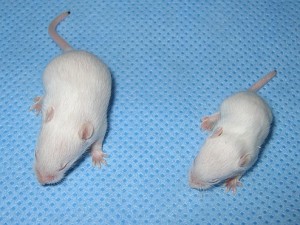
Replacing the missing SMN protein seems to strengthen muscles in mice -- but not in human trials. Now, a closer look at SMN's function offers up new leads for drug discovery.
Spinal muscular atrophy is sometimes referred to as a “Lou Gehrig’s disease of babies.” About 1 in 40 people carry the defective gene for this untreatable recessive disease, which causes progressive muscle degeneration and is the leading genetic killer of infants and toddlers. Affected children have weak, floppy legs and arms and must go on ventilators, too weak to breathe on their own.
Researchers have had some success in mouse models of spinal muscular atrophy by adding back SMN, the protein that’s missing or abnormal, or getting the mice to produce more of it. The mice live longer, and do seem to have stronger muscles. But not so in human clinical trials to date.
Looking for another approach, Mustafa Sahin and Judith Steen in Children’s F.M. Kirby Neurobiology Center asked a simple question: What does SMN do? Spinal muscular atrophy is a disease of motor neurons in the spinal cord, which tell the muscles to contract. Steen (who directs the hospital’s Proteomics Core) and postdoctoral fellow Bikem Akten began by using mass spectrometry to find out, first of all, what neuronal proteins SMN keeps company with.
One protein called HuD kept coming up. Both HuD and SMN itself, the research team found, indirectly regulate the secretion of a third protein, neuritin. Neuritin’s messenger RNA (in red) can be seen here mingling with SMN protein (green) in axons — the nerve fibers that branch from motor neurons to connect with muscle:
Meanwhile, working with collaborators at Ohio State University, the Steen and Sahin labs studied a line of tiny zebrafish that lack functioning SMN, and whose axons were clearly abnormal. “They branch in the wrong directions and don’t really reach the right muscle,” Sahin says. “We asked, ‘can we put back neuritin and make the axons normal?’”
You can see the results of his lab’s experiments – reported last week — in these images:
In the middle panel at right, SMN has been blocked, and the nerves branch off the spinal cord in irregular directions. In the bottom panel, adding neuritin RNA partially reverses this defect, so nerves reach the muscle.
That raises some big questions. Could neuritin, or a drug of similar action, be given somehow to babies with spinal muscular atrophy, and help restore the nerve-muscle connection and make their muscles stronger?
The researchers will soon begin to test this idea in mice. What’s encouraging is that neuritin acts on receptors on the cell surface (although their identity is still unknown), and is a small molecule, making it easier to work with.
“Spinal muscular atrophy is such a devastating disease currently,” says Sahin. “So far, the disease can be readily diagnosed, but there are no approved treatments. We can only try to manage the symptoms and prevent complications.”






